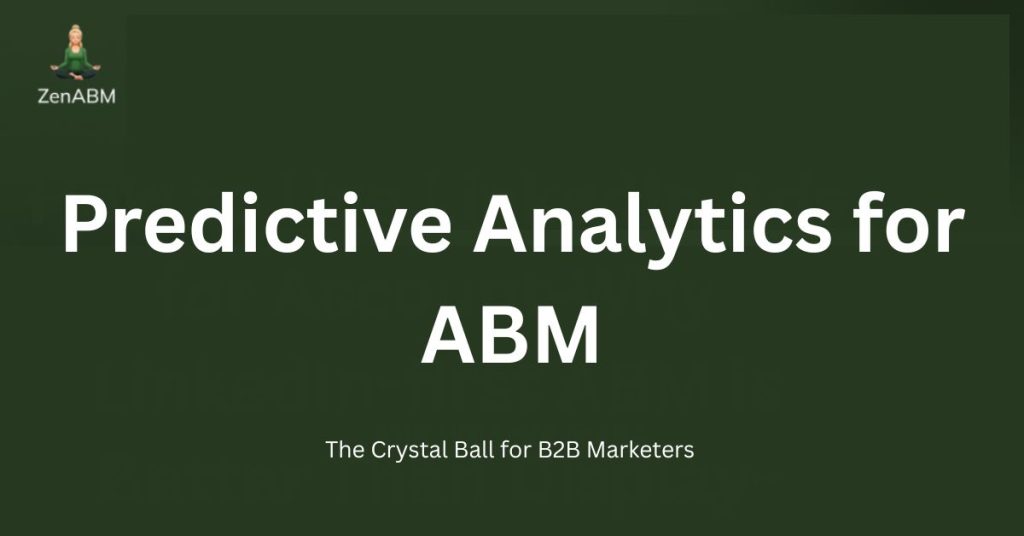Predictive analytics for account-based marketing (ABM) is something I hear ABM pros talking about, but it isn’t mainstream yet, and so it can be your edge!
And to help you ace it, I researched web and socials to bring you this ultimate guide on predictive analytics in ABM.
And I’ll be focusing less on high-level stuff and more on “do this now and thank me later” tips.
You’ll learn:
- How to harness predictive models to forecast account behavior
- Identify the hottest prospects before your competitors do,
- Personalize your outreach at scale
- Ultimately generate pipeline
- The role of ZenABM in all this
Let’s go!
Predictive Analytics for ABM: Quick Summary
- Predictive analytics helps scale ABM from a few dozen to hundreds of accounts by forecasting which accounts are most likely to engage and convert.
- Clean, integrated data is the foundation: CRM, marketing automation, LinkedIn ad engagement (via ZenABM), intent data, and firmographics.
- Predictive scoring allows objective tiering (Tier 1, 2, 3), blending account fit with intent signals, and triggering outreach when thresholds are crossed.
- Intent data shows which accounts are actively researching. When combined with predictive scores, you know both who is valuable and who is ready now.
- Personalization becomes more precise: tailor content to interests, buyer stage, and channel preferences; time outreach around engagement surges.
- Measurement matters: track pipeline created, win rates, deal size, cycle velocity, engagement rates, model accuracy, ROI, and sales adoption.
- ZenABM provides account-level LinkedIn engagement, intent tagging, funnel tracking, and revenue attribution to operationalize predictive ABM.
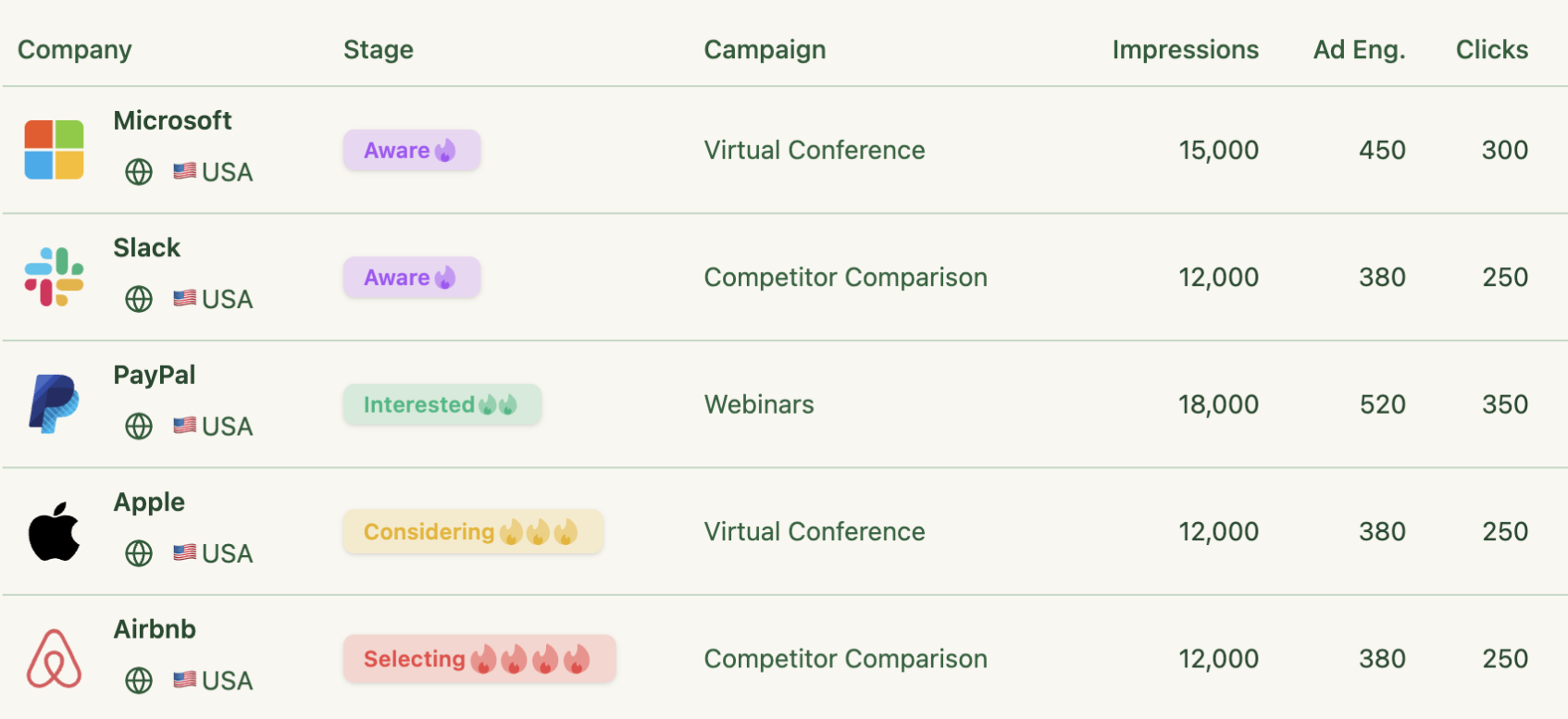
Why ABM Needs Predictive Analytics (Now More Than Ever)
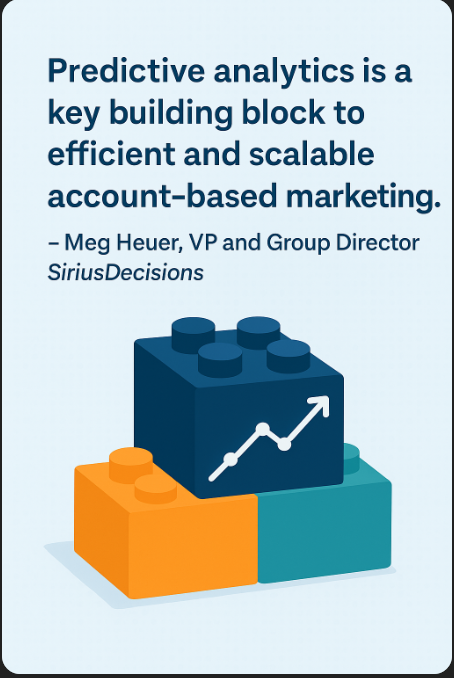
ABM isn’t new.
Savvy B2B teams have been focusing on key accounts for years.
Traditionally, though, most could only manage highly-personalized ABM for their top 20 or 50 accounts.
Scaling beyond that was brutal. In the words of one VP of Marketing who chronicled her first ABM campaign, “it’s brutal… there are no playbooks” for how to operationalize ABM at scale.
Predictive analytics changes that.
Leading marketers have found that the only way to scale ABM to hundreds or thousands of accounts is by adding predictive capabilities to their tech stack.
Why?
Because predictive analytics flips the script from reactive to proactive.
Instead of manually researching and debating which companies might be interested (and usually defaulting to the ones you think are good), predictive models crunch huge volumes of historical data to forecast which accounts are most likely to engage and convert.
How Predictive Analytics Works
Okay, so predictive analytics sounds awesome, but how does it actually work, and do you need a PhD in statistics to use it?
Nope!
See, at its core, predictive analytics in ABM uses historical data plus clever algorithms to predict future outcomes.
It’s about pattern recognition like this: “Our wins tend to be tech companies in fintech with >1,000 employees, that visited our pricing page 3+ times, and whose VP of Engineering engages with our LinkedIn ads. Let’s try to recreate such journeys.”
The Math: Algorithms, Models, and Formulas
Once the data is ready, the predictive platform applies machine learning algorithms to find patterns that correlate with conversion or other desired outcomes.
Common techniques include:
- logistic regression (to estimate the probability of a binary outcome like “becomes a customer”),
- decision trees and random forests (to handle lots of variables and nonlinear interactions),
- or even neural networks for complex patterns.
Don’t worry, you don’t have to do the math. That’s what predictive ABM tools are for.
Data: The Fuel that Powers Predictive ABM
Let’s drill down on the foundation of all this: data.
So, what data do you actually need, and how do you get it in shape?
1. Gather Data from All Sources (Break Down the Silos)
ABM by definition spans marketing and sales, so your data needs to as well.
Start by integrating data from your CRM, marketing automation, website analytics, advertising platforms, and any intent data feeds into one view.
Many companies use a customer data platform (CDP) or data warehouse to aggregate this.
At a minimum, ensure your CRM is enriched with key marketing data:
| Data Source | Key Data Points | ABM Value |
|---|---|---|
| CRM & Sales Data | Opportunities, deal history, account demographics, contact roles, past purchases, sales notes | Defines what a successful account looks like and captures past interactions |
| Marketing Automation & Website Data | Email opens/clicks, content downloads, webinar attendance, web visits (pricing/case study pages), form fills, event registrations | Reveals high-intent engagement from target accounts |
| Advertising & Social Data | LinkedIn ad impressions/clicks by account, other ad interactions (via tools like ZenABM) | First-party intent signal showing which accounts interact with campaigns |
| Third-Party Intent Data | Research activity from providers like Bombora, 6sense, Demandbase | Shows accounts actively investigating relevant topics across the web |
| Firmographics & Technographics | Industry, size, revenue, tools/software used (via LinkedIn, ZoomInfo, Clearbit) | Identifies account fit and patterns among the best customers |
| Unified Account Profile | Integrates all the above into one predictive model | Enables a 360° account view for scalable, efficient ABM |
2. Cleanse and Prep the Data
Once you’ve gathered the data, don’t skip this step.
Data quality issues can derail predictive models.
Ensure consistency and accuracy:
- Deduplicate accounts and contacts (nothing worse than “Acme Co.” and “Acme Corporation” being treated as separate when they’re the same). Merge records in your CRM and maintain a master account list.
- Standardize fields (e.g., job titles or industries) so that “VP Marketing” and “Vice President of Marketing” aren’t seen as totally different. Normalize categorical data where possible.
- Fill in missing critical data. If employee count or industry is blank for many accounts, consider an enrichment tool to fill those gaps, since firmographic fit is often a key predictor.
- Remove or flag junk data: test accounts, ISP visitors in web analytics, etc., so they don’t skew the model.
- Garbage In, Garbage Out: It’s worth reiterating. One study found that up to 30% of CRM data is stale or inaccurate in a given year, so do a sweep.
Pro Tip: For CRM cleaning, Tarek Reda (Founder at Blue Pencil Marketing Agency) shared his automated workflow:
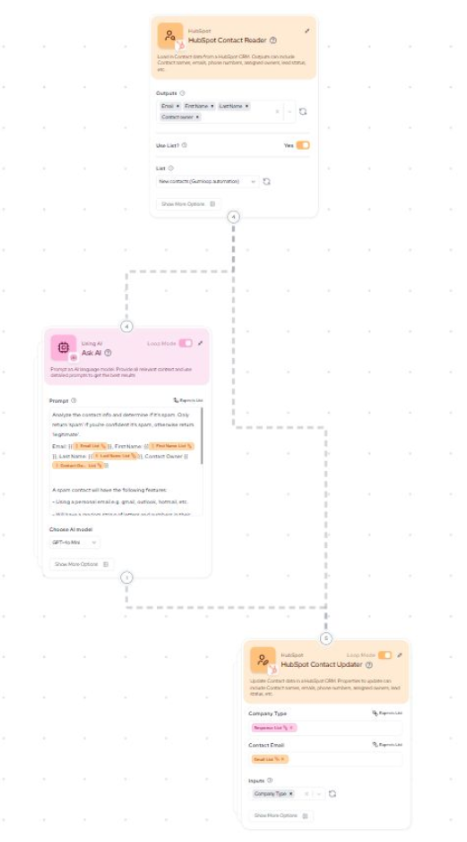
- Build a HubSpot list of leads added yesterday.
- Send the list to Gumloop.
- AI checks for signs like personal emails, random strings, and missing owners. It labels each record as “spam” or “legit.”
- Write the label back to the CRM.
It runs in the background and keeps your data healthy so you can focus on more important things in predictive ABM.
3. Segment and Define Your Target Universe
Clearly delineate which accounts are in play for your ABM efforts, because the model is going to score whatever list you give it.
Most likely, you’ll have an Ideal Customer Profile (ICP) or a few ICP segments that define the kind of companies you want to pursue.
Use that as a filter. For example, if you only sell to the FinTech industry and companies with >200 employees, make sure your account dataset is limited to those.
Predictive analytics can then rank within that relevant universe, rather than suggesting accounts that don’t make sense for your business.
It’s all about feeding in good data!
At Userpilot (product management SaaS), they realized something mid-way in their ABM campaign: certain data (like website visits by target accounts) wasn’t reliable since many visitors were anonymous.
Their fix?
Simplify and lean harder on LinkedIn ad engagement data, which was
clearly tied to accounts.
They piped this into HubSpot CRM, first using Fibbler for raw counts, then ZenABM for detailed, campaign-level intent signals.
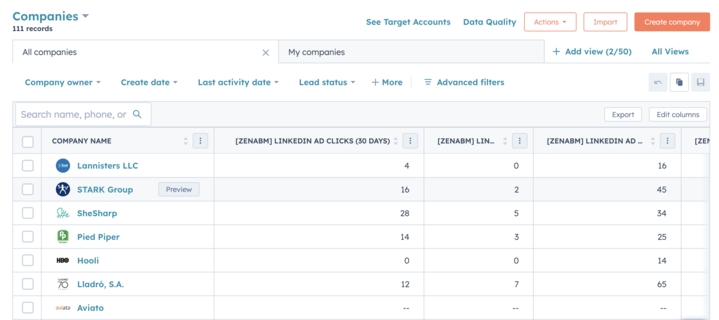
This gave visibility into which campaigns each account engaged with, like whether they clicked ads about onboarding vs. analytics features, providing vital context on
account interests.
That qualitative intent data was stored in CRM fields and armed BDRs for sharper outreach (“Company X is interested in analytics features, so lead with that in your email”).
Takeaway: By getting the right data (1st party LinkedIn intent) in and
scrapping the wrong data (flaky web tracking), Userpilot dramatically improved their ability to score and act on accounts. Feed your predictive model the good stuff.
Scoring and Prioritisation: Finding the Whales
With clean, integrated data and a predictive model at your disposal, you’ll now get to the fun part: scoring and prioritizing accounts.
Predictive analytics will typically output some form of score, grade, or ranking that lets you stack rank your target accounts from hottest to coldest.
Account Scoring 101 – Going Beyond Gut Feeling
Traditional lead scoring (in marketing automation platforms) often used a few rules: e.g., +10 points if job title is C-level, +5 if they clicked an email, etc.
On the contrary, predictive scoring weighs dozens or hundreds of signals in ways our human brains can’t and it keeps learning.
The outcome for ABM is that every account (and often every contact) gets a score indicating its propensity to convert.
How you interpret and use that score is key:
- Tiering Accounts: Divide accounts into tiers (e.g., top 10% = Tier 1) to determine the level of personalisation and sales effort they receive. Predictive scoring makes this objective.
- Fit vs. Intent: Look at both. Fit = how well the account matches your ICP (static). Intent = how much interest they show now (dynamic). Best practice: plot them on a Fit vs. Intent matrix, and your sweet spot is high–high.
- Score Thresholds & Triggers: Define what score is “hot.” Example: if an account passes 80/100, auto-alert BDRs and assign follow-up. Tools like ZenABM can assign hot accounts to BDRs in your CRM:

ZenABM assigns your BDRs to accounts in the “interested” st - Dashboards in Action: Engagement data (ad clicks, site visits) roll into predictive scores. High scorers get flagged green for outreach; low scorers stay in nurture.
- Efficiency Gains: Prioritization stops sales from wasting time. Reps start each day focused on the highest-potential accounts, which shortens cycles and raises win rates.
- Hidden Gems: Models often reveal overlooked segments like mid-market or adjacent industries you weren’t targeting but should.
- Concrete Example: Company X scores 95/100 due to ICP fit, ad engagement, site visits, and fresh funding. They go into 1:1 outreach. Company Y at 40/100 gets nurture only.
- Scaling: Scoring lets you confidently expand ABM from dozens to hundreds of accounts without losing focus.
Note: Keep calibrating. Scores shift as new data arrives; feedback from sales helps retrain models. Treat scores as a compass, not gospel.
Intent Data: Knowing Who’s Actually Interested (and Combining it with Predictive)
Intent data refers to observable signals that indicate a company is researching or considering solutions related to your product, while predictive analytics shows which accounts are likely to be valuable.
Intent data has two types:
- First-party intent: actions tracked on your own channels, such as website visits to pricing or product pages, whitepaper downloads, webinar registrations, or ad engagement. ZenABM, for instance, can help you with gathering first-party quantitative and qualitative intent from LinkedIn ad engagements:

- Third-party intent: actions tracked outside your properties, through providers like Bombora, ZoomInfo, or 6sense. These vendors monitor activity across publisher networks and map it to accounts. For example, multiple employees from an account reading about a specific technology.
Why Intent Data Matters
Here’s how intent data helps:
- Account Prioritization: If multiple people at a target account are engaging with content related to your product category, that account should move up your priority list. Predictive scoring often uses this data to assign higher scores.
- Message Personalization: Knowing what topics an account is researching allows you to adjust messaging. If intent data shows that Company A is researching compliance automation, outreach can highlight your compliance features.
- Timing and Channels: Intent signals are time-sensitive. If an account is active now, outreach should happen now. Predictive scoring can incorporate changes in intent to suggest the right time to act, not just the right account.
Combining Intent with Predictive Models
Here’s how you should act based on a combination of predictive analytics and intent data:
- High fit + high intent: engage immediately with focused outreach.
- High fit + low intent: maintain contact and provide education until signals rise.
- Low fit + high intent: review individually (sometimes worth pursuing despite weaker profile fit).
- Low fit + low intent: deprioritize.
Predictive analytics handles the ranking across large lists. Intent data provides a second layer of clarity by showing which accounts are currently active.
How to Apply Intent Data in ABM
Apply like this:
- Add intent fields to your CRM or predictive model, even as simple as “intent surge: yes/no.”
- Set score thresholds that trigger workflows. For example, if an account crosses 80/100 and shows intent activity, automatically notify the BDR team.
- Use first-party intent from LinkedIn ads using ZenABM. It captures company-level ad engagement for each ad creative and pushes it into CRM fields, so sales knows which campaigns or features attracted attention. You can, in fact, tag each campaign with an intent, and ZenABM will then group companies showing similar intent together and also push intent as company property to your CRM.


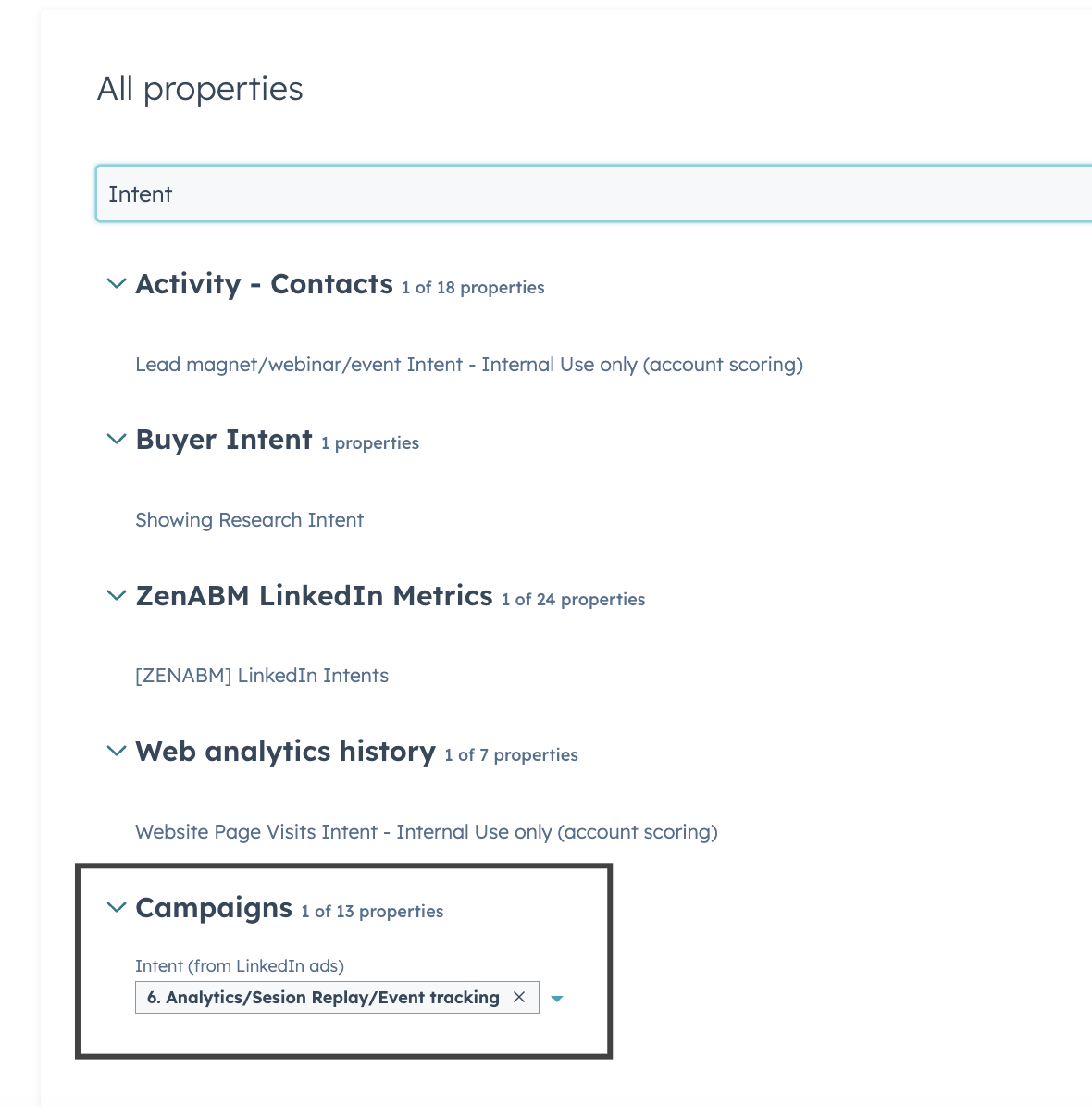
Pushing intent as property in ZenABM - Apply intent beyond acquisition. If a customer shows intent on features they don’t yet own, treat it as a cross-sell opportunity. If engagement drops, treat it as a churn risk.
Personalization and Timing: Delivering the Right Message at the Right Moment
A core promise of ABM is personalization at scale by treating each account with personalized messaging.
Predictive analytics strengthens this by telling you what to say and when to say it.
Using Predictive Insights for Content
Here’s how use can use predictive analytics in ABM to personalize your content/messaging, i.e the ‘what to say’ part:
- Topic Interest Personalization: If Account ABC engages heavily with “analytics” content, lead with analytics in ads, emails, and calls. IBM has shown this approach drives significantly higher engagement.
- Buyer’s Journey Stage: Predictive models can signal whether an account is in early research (feed them educational content) or in consideration (provide comparison guides, ROI calculators). Also, for determining the ABM stage based on first-party LinkedIn ad engagement data, you can use ZenABM:
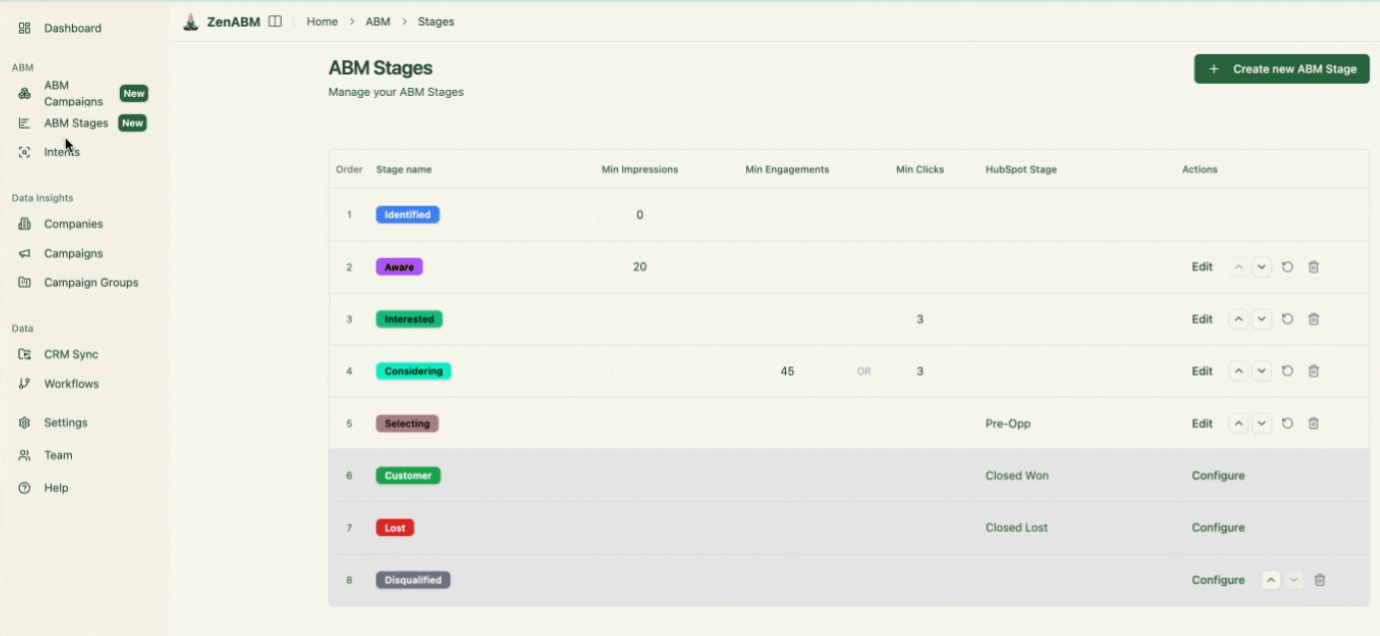
- Channel and Format Preferences: Data may show technical roles prefer webinars, while execs prefer reports. Match outreach to the formats and channels each segment actually engages with.
- One-to-One Customization: For top-tier accounts, predictive insights support bespoke campaigns like custom case studies or personalized video messages.
Effective personalization is more than dropping a {{CompanyName}} token.
It’s aligning messaging to known priorities. Predictive-driven personalization has been shown to improve engagement, conversions, and retention.
Timing Outreach with Predictive Signals
Timing often determines whether outreach is ignored or accepted.
Predictive ABM improves accuracy here.
- Surge Response: If engagement spikes (multiple visits in a week, repeated ad clicks), act immediately. Automated alerts ensure sales reaches out while interest is high.
- Cadence Optimization: Models can guide outreach frequency. Hot accounts may warrant a compressed touch pattern, while cooler accounts benefit from slower nurturing.
- Ad Timing and Spend: Platforms like Demandbase adjust ad bids in real-time based on predictive signals, ensuring spend focuses on accounts most likely to convert.
- Avoiding Missed Signals: Predictive alerts prevent missed buying windows by flagging renewed activity.
Measuring Predictive ABM Performance
Predictive analytics not only improves ABM results, but it also creates better ways to measure them.
The key is to tie metrics directly to business outcomes, so you can prove impact and adjust where needed.
1. Pipeline and Revenue Metrics
These are the must-track pipeline and revenue metrics:
- Pipeline Created: Track pipeline ($) generated from predictive-flagged accounts. Compare before vs. after adoption. Example: Userpilot drove $650k in 90 days, a sharp uptick from inbound-only.
- Win Rate: Compare win rates for high- vs. low-scoring accounts. If Tier A wins at 30% and Tier C at 10%, the model is clearly guiding focus.
- Deal Size / LTV: Measure if predictive-targeted accounts deliver bigger deals or higher lifetime value.
2. Conversion and Velocity Metrics
Conversion and velocity metrics that must be tracked:
- Target-to-Opportunity Conversion: What % of predictive-prioritized accounts become opportunities? Compare against baselines.
- Sales Cycle Length: Focused outreach should shorten the time to close.
- Stage Progression: Track how accounts move stage-to-stage (e.g., Aware → Consideration → Closed) and whether predictive scores correlate with progression.
3. Engagement Metrics
Engagement metrics thst must be tracked:
- Account Engagement Scores: Monitor if target accounts are hitting “high engagement” zones more often.
- Content/Ad Interaction: CTRs, email responses, and event attendance should improve with personalization.
- Web Traffic from Target Accounts: Rising visits from named accounts indicate predictive targeting is working.
- Account Penetration: Track the breadth of contacts engaged within each account.
4. Model Efficacy
Efficacy stuff that must be tracked:
- Score Accuracy / Lift: Are top-scoring accounts converting at much higher rates?
- Coverage of Wins: Did the model miss closed-won accounts? If yes, retrain.
- User Adoption: Track sales usage of predictive dashboards and responsiveness to alerts.
5. ROI and Efficiency
ROI and efficiency metrics that must be targeted:
- Pipeline per Dollar: Measure pipeline or revenue generated per $ spent. Predictive ABM often improves this dramatically.
- Resource Allocation: Are reps focusing on fewer, better accounts and hitting quota faster?
Presenting Impact
Tie outcomes directly to goals:
- “Win rate rose from 20% to 35% for predictive accounts, with 20% larger deal sizes.”
- “Pipeline created doubled year-over-year, with 50% better pipeline-per-dollar efficiency.”
Add qualitative proof: sales feedback (“the scores point me to my fastest closes”) or customer quotes (“your outreach came exactly at the right time”).
Iterate and Refine
If conversion rates aren’t improving, thresholds may be too low.
If engagement isn’t rising, personalization or content needs work.
Predictive ABM makes the funnel measurable and transparent, but continuous refinement is essential.
ZenABM for Measuring ABM Success
If your major ABM ad channel is LinkedIn, ZenABM is all you need to track all sorts of progress metrics and attribution details.
- It tracks clicks, engagements, impressions, and ad spend of each ad creative/campaign or campaign group at the company-level:

ZenABM dashboard showing company-level ad engagement data per campaign by pulling first-party intent signals from the LinkedIn API - It shows a comparative view of how each ad campaign impacted an account:

- It shows the number of accounts in each stage and their progress from one stage to another in a given period of time, so you can conduct funnel leak analysis and calculate pipeline velocity:

- It calculates an engagement score for each account based on the overall engagement of the account with all the ad campaigns of your brand. These scores are both current and historic:

- Also, as ZenABM can match ad-engaged companies with the deals in your CRM to calculate campaign effectiveness and revenue metrics like ROI, ROAS, pipeline per dollar spent, and the like:


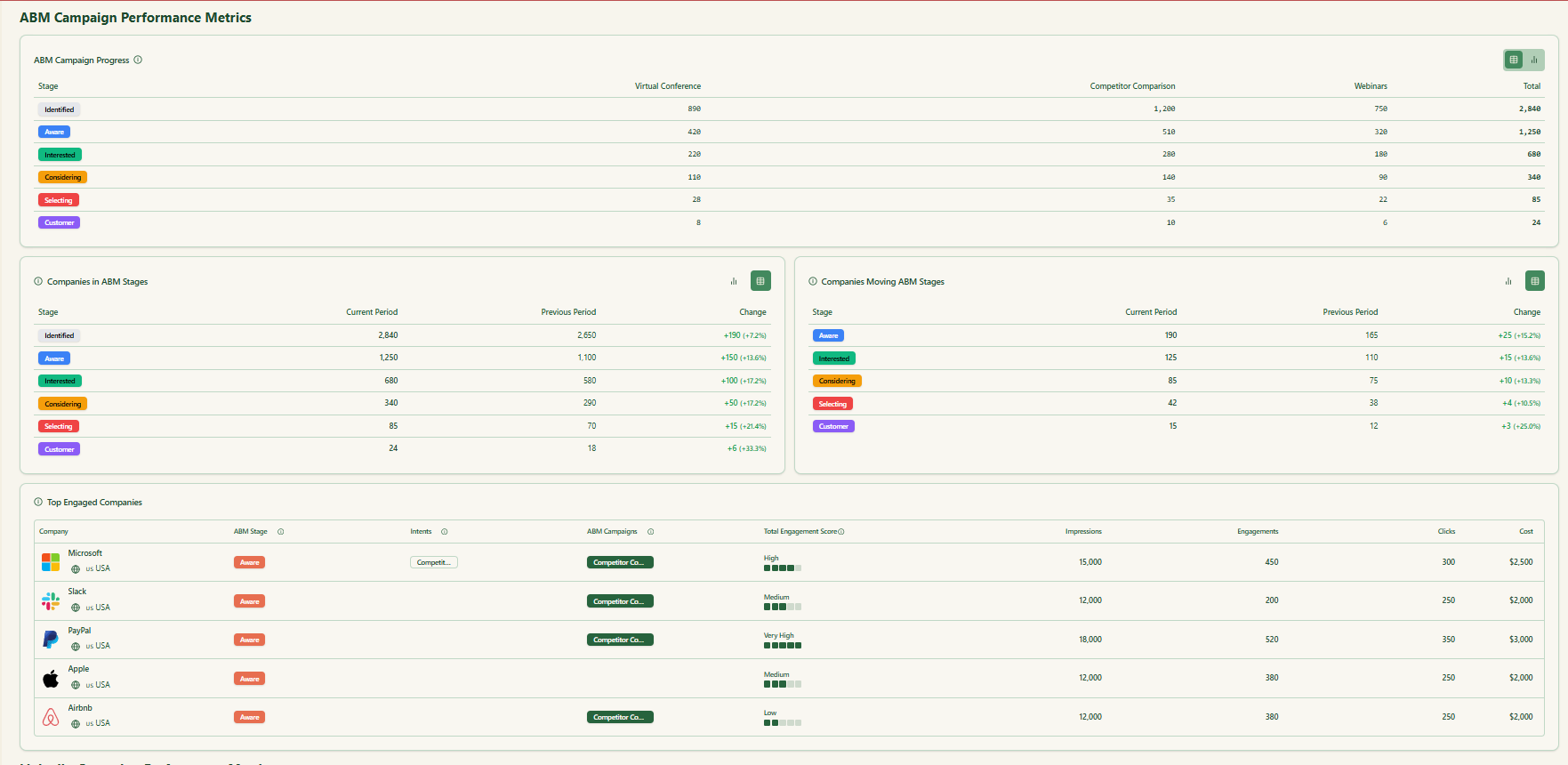

Predictive Analytics for ABM: The Conclusion
Predictive analytics turns ABM from guesswork into a structured, scalable process.
By combining account fit, intent data, and engagement patterns, teams can prioritize the right accounts, deliver timely and personalized outreach, and measure real business outcomes.
With tools like ZenABM, predictive ABM becomes practical by helping marketing and sales focus effort where it drives the most revenue.

